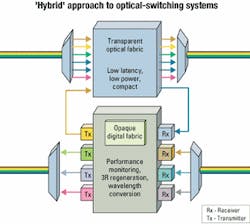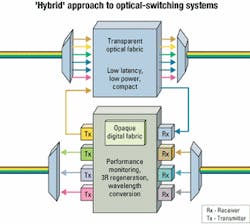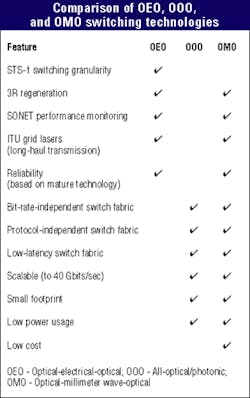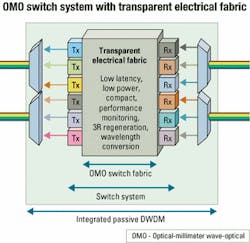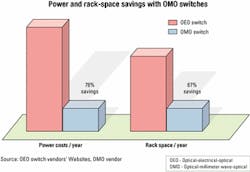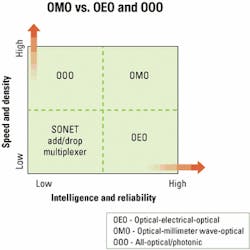Optical switching for next-generation networks
Optical-millimeter wave-optical switches are a true hybrid of OEO and all-optical technologies.
MAZEN SALLOUM and DR. SHANTANU MITRA, TeraBurst Networks
Optical networks are constantly evolving, spurred by changing traffic requirements and innovative advances in networking technology. In the recent past, advances in optical networking have focused on increasing bandwidth availability in WANs. Increases in fiber infrastructure and improvements in DWDM and amplification technology have resulted in improved transmission economics with lower cost per bit.
The increasing need to efficiently manage this bandwidth and the large numbers of wavelengths being deployed across MANs and WANs have led to the emergence of a new product class: optical switches. The first generation of optical switches can be grouped roughly into two categories: optical-electrical-optical (OEO) and all-optical, or photonic (OOO). Each type of switch has both strengths and weaknesses. Yet an approach such as optical-millimeter wave-optical (OMO) combines the strengths of these two approaches to create a truly next-generation switching architecture.
Today's core networks are optimized for voice traffic based on SONET/SDH transmission protocols that have the following advantages: standard framing specifications with interoperable multivendor equipment, a well-defined hierarchy of signals that allows for scalability of data rates, performance monitoring, and automatic protection switching. But to address the growing needs of data traffic, telecommunications service providers are challenged with combining voice, data, and high-definition video traffic onto one integrated network infrastructure.
Optical-switching systems have emerged as one of the main building blocks for addressing the needs of this new integrated network infrastructure. These network elements also enable the development of new network architectures. Currently, network architectures are commonly of the "overlay" type (e.g., IP/ATM/SONET/ DWDM). A new and simplified architecture based on an IP/MPLS layer over an intelligent optical layer incorporated into the optical switches appears to be more desirable.The intelligence in the optical layer can typically include all the attractive features of SONET/SDH, while also incorporating the evolving Generalized MPLS technologies for network-level intelligence. Primary driving forces for this migration include the growth in Internet usage leading to data traffic exceeding voice traffic; the desire to develop standards-based network intelligence to enable the necessary level of interoperability; and the trend to migrate from explicit SONET ring architectures that are expensive to upgrade and slow to provision.
The introduction of an optical control plane, which performs automatic topology discovery along with flexible protection schemes, is an example of the intelligence being incorporated into optical switches today.
Features for the next generation of optical switches can be summarized as follows:
- Intelligence and reliability. Performance monitoring, 3R (retransmit, reshape, and retime) regeneration, wavelength conversion, and carrier-grade reliability (99.999%).
- Speed and density. Bit-rate- and protocol-independent, scalability (port speed, switching capacity), and cost-effective design (power consumption, footprint).
Thus, due to the optical-electrical (OE) conversion, opaque OEO switches have the capability to perform the intelligence and reliability features listed earlier. Carrier-grade reliability can be achieved since the fabric comprises solid-state switch devices manufactured using standard, well-established fabrication processes.
Opaque OEO switches do have some limitations. The digital nature of the switch fabric provides an impediment to scalability, since the total capacity of the switch is fixed. For example, a fixed switching capacity of 160 Gbits/sec (3,072 STS-1s) provides a 64x64 OC-48 (2.5-Gbit/sec) OEO switch that "upgrades" to a 16x16 (10-Gbit/sec) OC-192 switch.
Additionally, these OEO switches are protocol-dependent (currently, only SONET/ SDH signals are switched), and the switches tend to have relatively high ingress-to-egress latencies. They also tend to have large footprints and consume considerable amounts of power due to the active nature of digital switch fabrics.To address these concerns, several efforts are underway to commercialize transparent OOO switches. These switches redirect the paths of optical signals using a variety of technologies like micro-electromechanical systems (MEMS), liquid crystals, thermo-capillary, and dielectric fluid total internal reflection. Today, MEMS (two-dimensional and three-dimensional) is closest to being commercially deployed, and several companies have announced products based on this technology.
OOO switches are independent of bit rate and protocol but typically lack the ability to do performance monitoring (e.g., SONET-level) or regenerate the signal after it passes through the switch. That is aggravated by an average insertion loss through the switch fabric of between 5 and 10 dB. In case of serious signal attenuation, 3R regeneration can be added externally at a higher cost.
More important, carrier-class reliability in the current generation of OOO switches remains to be proven. Some of the concerns relate to the proliferation of moving parts, the possibility of sticking friction in the micro-mechanical assemblies, and the need for stringent environmental controls.OOO switches, however, meet the speed and density features listed previously, because of their transparency and compact design. Besides bit-rate and protocol independence, switch-fabric transparency results in low latency and power consumption. That makes them suitable for deployment in the core of "all-optical clouds" where switching is needed at the wavelength level.
In fact, depending on the geographical location of the switch, a large proportion of wavelengths in DWDM environments are simply switched and passed through without subwavelength grooming. In these cases, wavelength-level switches are far more efficient and economical than the digital OEO switches.
Recognition of the limitations associated with OEO and OOO switch technologies has resulted in a recent trend toward a hybrid approach. Systems vendors are now trying to incorporate functionality of both technologies into a single system. However, the approach thus far has been to combine two switch fabrics (OEO and OOO) within the same system. That is depicted in Figure 1, which shows the juxtaposition of two distinct fabrics with their individual characteristics. Traffic that needs to be passed through is managed by the transparent optical fabric, while traffic that needs performance monitoring, wavelength conversion, or 3R regeneration is handled by the OEO portion of the hybrid.
The dual-fabric hybrid approach is equivalent to two mini switch fabrics in one system, each still retaining its individual limitations. Moreover, this design approach is rigid since it requires service providers to have a priori knowledge of the traffic patterns to determine the relative sizes of the OEO and OOO fabrics. Once this determination has been made, it is difficult to change the ratio of OOO/OEO traffic, unless the system architecture is flexible enough to allow the change. The dual-fabric design is also inherently more complex to design if true hybrid functionality (and not just interoperability) is desired.
Recently, a truly hybrid approach to optical switching has been developed using unique, robust analog switch devices capable of operating in the millimeter-wave range (equivalent to OC-768 rates). This switching technology, labeled optical-millimeter wave-optical (OMO), is a variation of the existing technology in OEO switches, which have "opaque" electrical fabrics and realize switching through digital processing.
The OMO switch systems also contain electrical fabrics, but they switch analog electrical data streams in a manner similar to the OOO fabrics. That is due to the fact that the OMO system is a space switch, with the switch devices providing route selection within the fabric for strict-sense nonblocking connectivity from any input port to any output port.No complex modulation schemes are employed in the fabric, and insertion loss, return loss, and isolation parameters have been optimized for proper performance. The fabric is transparent to bit rate and transmission protocols, which also resemble the OOO switches. The wideband switch devices enable the system to switch wavelengths in DWDM environments, from OC-3 to OC-192 rates today, and millimeter-wave capability in the switch devices provides a clear upgrade path to OC-768 rates when the appropriate 40-Gbit/sec optics become available. A schematic of the OMO switch is shown in Figure 2.
Scalability of the OMO switch is similar to the OOO switches. Thus, an increase in the line rate from OC-48 to OC-192 does not result in a fourfold decrease in port count, as is the case with the digital OEO switches. The OE conversion in the line cards allows for performance monitoring of overhead bytes in the SONET frame. Additionally, the OE conversion allows 3R regeneration-similar to the OEO switches-and provides the ability to perform wavelength conversion at the egress ports of the OMO switches when ITU-grid lasers are incorporated into the system.
Integration of passive DWDM functionality into the switch system adds an additional measure of versatility, as the management systems for link management and network-level protection and restoration become more integrated.
OMO technology provides other significant advantages. Specifically, the devices used to construct the fabric are all-passive and thus consume very little power. In fact, the power consumption per Gbit/sec (switch capacity) of a complete switch system based on the OMO approach can be several times less than equivalent OEO switches (e.g., 4 W/Gbit/sec versus <16 W/Gbit/sec).
Secondly, the transparent electrical fabric results in very low latency (in the nanosecond range) and a very compact size, even for high-capacity systems. For example, a 640-Gbit/sec system can be developed in a half-rack size, allowing for significant space savings over existing OEO switches (see Figure 3).
Finally, the availability associated with the switch system has been calculated to meet carrier-class requirements handily. That is primarily due to the use of fabrication techniques that have been developed in the wireless and satellite communications industries, resulting in not only highly reliable devices, but also in a lower-cost product. Consequently, the OMO switch system has a significantly lower price tag.
A comparison of the OEO, OOO, and OMO switching technologies is shown in the Table on page 78; As can be seen from the Table, OMO technology combines the advantages of the existing digital OEO technologies with the promised benefits of photonic switching in a single compact switching platform, thus offering a true hybrid approach.
As highlighted above, OEO and OOO optical switches offer a subset of the desired set of features for an optical switch, but neither can offer the entire suite. OEO optical switches cannot scale to meet the requirements of tomorrow's core networks, and OOO optical switches have yet to prove their reliability or provide the performance monitoring through purely optical means.
OMO optical switches combine the reliability and signal quality associated with OEO systems, with speed and scalability that can be obtained from the OOO switches (see Figure 4). Considering the requirements of next-generation optical networks, the need for a complete offering is paramount. Only an all-encompassing solution coupled with optical layer intelligence will address these requirements and enable widespread adoption of optical switching.
Mazen Salloum is product marketing manager and Dr. Shantanu Mitra is director of marketing at TeraBurst Networks (Sunnyvale, CA). They can be reached via the company's Website, http://www.teraburst.com.
